Top 10+ AI Agent Frameworks Enterprises Should Know About in 2025
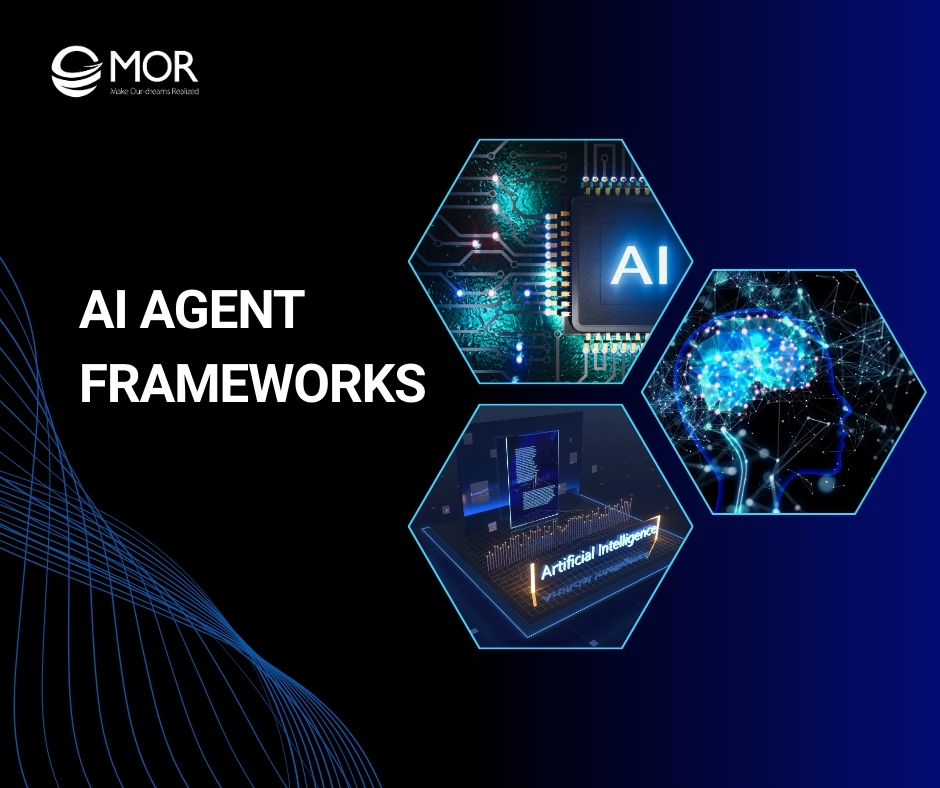
Choosing the right AI agent frameworks is tough with so many tools claiming speed, scalability, and smarter automation. In this guide, MOR Software highlights the top frameworks of 2025 to help you pick the best AI agent framework for your enterprise goals.
What Are AI Agent Frameworks?
AI agent frameworks are structured toolkits that give developers ready-made components to create intelligent systems without having to code everything from the ground up. They can power anything from a single, task-specific agent to a sophisticated multi agent framework managing multiple autonomous processes.
Adoption of generative AI is now mainstream, with McKinsey reporting that 71% of organizations regularly use it in at least one business function.
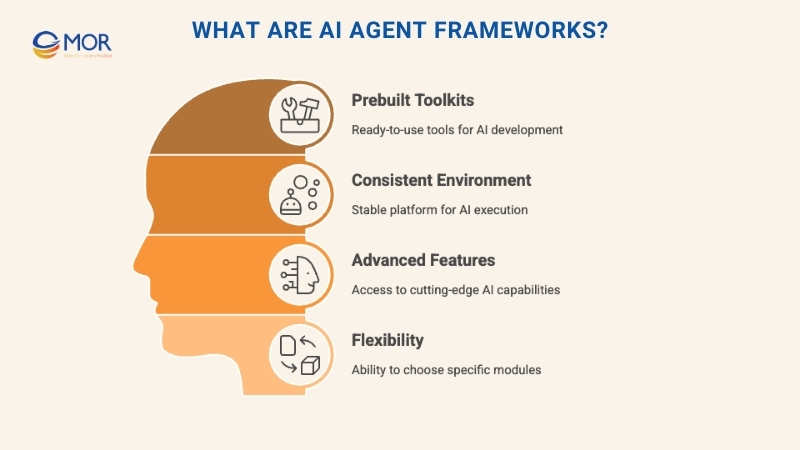
These frameworks act much like an operating system for AI, providing both a consistent development interface and a reliable execution environment. By doing so, they remove much of the heavy lifting involved in setting up and managing AI-driven workflows.
For enterprises, using an AI agent framework means gaining access to advanced features right away while keeping the flexibility to select only the modules and capabilities that match their unique project requirements.
IDC projects global enterprise spending on custom AI solutions to reach about 307 billion dollars in 2025, a signal that companies are scaling these systems with urgency.
Core Components Of AI Agent Frameworks
Most AI agent frameworks share a similar internal setup that allows them to move structured data efficiently between different processes and tools. This consistent design helps ensure smooth coordination when developing and running agents.
Below is a breakdown of the main elements and how they function during agent development:
Component | What It Does |
| Agent Architecture | Defines how the agent thinks, plans, and responds, often built around decision-making or conversational logic. |
| Environment Interface | Links the agent to its working environment, such as a website, app, or chat platform. |
| Task Management | Controls the workflow, deciding how tasks are assigned, ordered, or adapted when objectives shift. |
| Communication Protocols | Facilitates structured interaction between agents, enabling them to collaborate or delegate tasks. |
| Memory Systems | Holds essential context and knowledge so agents can maintain consistency across sessions, often using a knowledge base. |
| Tool Access | Lets agents take real actions by connecting with external systems, APIs, or datasets. |
| Monitoring & Debugging | Offers insight into agent behavior for troubleshooting and refining performance over time. |
Benefits Of Using AI Agent Frameworks In Enterprise Projects
Implementing the right AI agent frameworks can streamline development, reduce repetitive setup work, and unlock more consistent performance. Below are some of the most valuable advantages enterprises can gain.
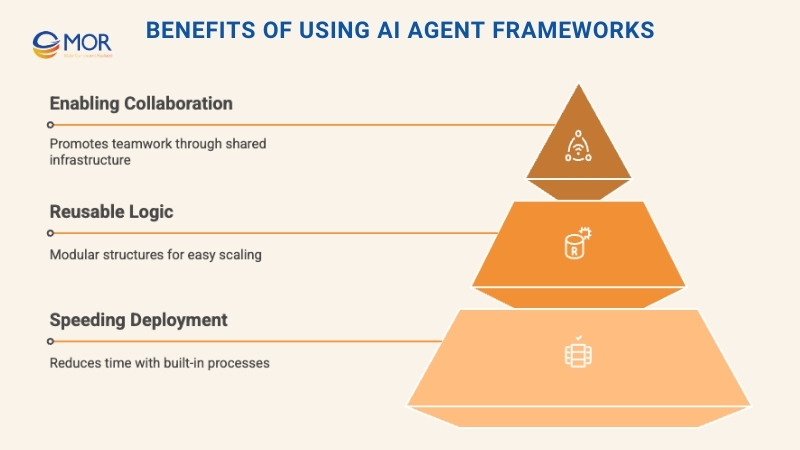
Speeding Up Deployment With Less Manual Setup
McKinsey’s 2024 AI report notes that 65% of organizations now work with generative AI on a regular basis, yet many still struggle to move from testing to production efficiently.
When teams build their own infrastructure for machine learning models, handling data inputs, outputs, chaining steps, and API calls by hand, they are 1.5 times more likely to spend over five months before going live. This slows innovation and drains resources.
By using AI agent frameworks, businesses avoid reinventing the wheel. These frameworks come with built-in processes for connecting tools, managing workflows, and orchestrating model interactions. That means teams can skip repetitive setup tasks and focus on delivering working solutions faster.
Reusable Logic For Scaling Across Different Agents
With AI agent frameworks, much of what appears “intelligent” comes from well-structured, reusable steps that can be applied across multiple agents or workflows.
When this logic is organized within the framework as modular units, it becomes as straightforward to call as running a simple function like add(2,3) in Python. This modularity lets developers solve user challenges creatively without wasting time recreating the same reasoning structures for every new project.
Rather than locking every process into a rigid standard from the start, teams can operate more like product designers, experimenting, refining, reusing proven components, and expanding them to power new AI agents framework use cases efficiently.
Enabling Collaboration Through Shared Infrastructure
When multiple AI agents operate on a common infrastructure, such as cloud environments or centralized inference servers, the agentic AI framework they rely on plays a major role in how well teams can work together.
A shared framework brings structure and transparency, making collaboration both manageable and predictable. It works much like coordinating work inside a shared Google Sheet for agent behavior:
- Clear logic ownership, each part of the agent has an assigned owner who maintains and updates it.
- Safe modifications, reasoning flows, tool integrations, and memory functions can be updated without creating conflicts.
- Trackable revisions, all edits to configurations and workflows are versioned for easy auditing.
- Cross-functional visibility, even non-developers can review and understand how the agent operates without having to read code.
Top 10+ Leading AI Agent Frameworks For Business Use In 2025
As AI agents advance, the AI agent frameworks powering them are also becoming more sophisticated. We’ve highlighted a selection ranked for enterprise suitability, security, and ease of integration into existing systems.
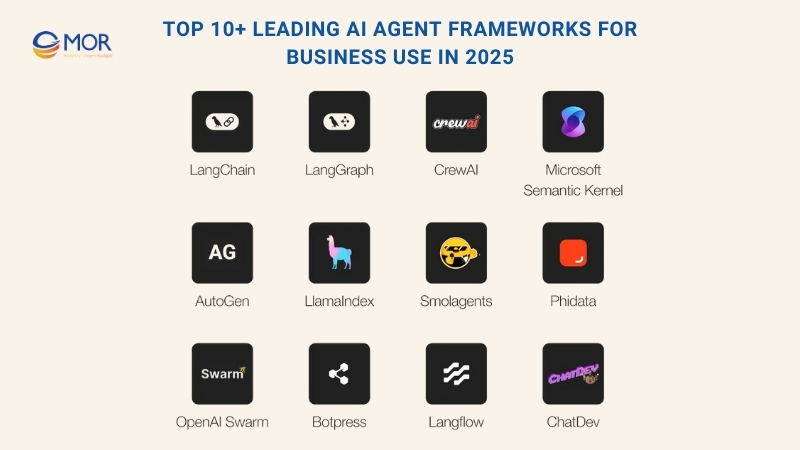
LangChain
- Best for: Enterprise AI workflow automation
- Strengths: Excellent LLM integration, supports modular and reusable development
- Weaknesses: Steeper learning curve for beginners, limited native debugging features
- Applications: Chatbots, document automation, AI-based decision systems
LangChain is a flexible agent AI framework designed for creating and deploying AI solutions powered by Large Language Models (LLMs).
It comes equipped with capabilities for text generation, translation, summarization, and question answering, enabling the development of systems for content creation, multilingual support, and knowledge retrieval.
Its ability to chain together multiple AI models and tools makes it ideal for building advanced workflows, such as sales automation that scores leads, personalizes outreach emails, and analyzes campaign data.
While powerful in automating complex processes and supporting prompt engineering, it can feel daunting for new developers due to its complexity and the time required to master its features.
This makes LangChain one of the most versatile AI agent frameworks for enterprises aiming to automate complex processes.
LangGraph
- Best for: Enterprises implementing automated human-in-the-loop AI
- Strengths: High transparency at each stage, supports complex multi-agent workflows with adaptive decision-making
- Weaknesses: Less suited for simple, single-agent deployments
- Applications: Automated customer support, legal document review, enterprise risk evaluation
LangGraph, which works seamlessly with LangChain and LangSmith, is a library designed to build both agent and multi-agent workflows. It can visually map every decision, step, and interaction, making it especially effective for orchestrating multi-step processes.
Its core strength lies in automated decision-making combined with human-in-the-loop functionality, where human input is incorporated at key stages.
For example, a multi agent framework could pause for manual review in customer support or require sign-off for high-stakes risk assessments. While powerful, developers unfamiliar with graph-based logic and multi-agent coordination may need time to adjust to its approach.
CrewAI
- Best for: Businesses seeking organized AI teams with defined roles
- Strengths: Enables sequential or hierarchical execution across multiple agents
- Weaknesses: Rigid task execution, less flexible in unpredictable scenarios
- Applications: Market research, automated data analysis, content production
CrewAI stands out among modern AI agent frameworks for its ability to structure agents like a collaborative team of specialists. Each with a distinct role, goal, and assigned responsibility. This structure makes it well-suited for building role-based AI systems that require smooth collaboration between agents.
Enterprises can integrate CrewAI with various external tools to collect data, spot trends, and produce detailed reports. It works particularly well for structured processes like content creation, where dedicated agents handle research and writing, or for project management, where complex tasks are broken down, assigned, and tracked.
While highly efficient for predefined workflows, this agentic AI framework is less adaptable for projects demanding spontaneous decision-making or dynamic role changes.
Microsoft Semantic Kernel
- Best for: Large organizations embedding AI agents into Microsoft products
- Strengths: Deep integration with Microsoft’s ecosystem, including enterprise AI software and services
- Weaknesses: Certain features remain experimental, with limited documentation and occasional stability concerns
- Applications: AI assistants, chat completion agents, workflow automation
Microsoft Semantic Kernel is an open-source AI agent framework designed to connect AI models, including LLMs, directly into enterprise applications.
It provides structured processes to arrange agent tasks into clear, executable steps, making it a strong choice for automating workflows like sorting emails, summarizing meetings, and managing IT support tasks.
One of its key advantages is enabling gradual AI adoption within legacy systems, allowing businesses to integrate new capabilities without a complete code overhaul.
Enterprises already operating within the Microsoft environment can link Semantic Kernel to services such as Outlook and Dynamics 365 for seamless collaboration. That said, organizations relying on non-Microsoft platforms may encounter extra effort when handling integrations, even though the framework is open source.
AutoGen
- Best for: Enterprises aiming to develop multi-agent AI systems
- Strengths: Supports coordinated multi-agent development for real-time environments
- Weaknesses: Less effective for large-scale enterprise AI requiring advanced reasoning and high adaptability under heavy loads
- Applications: Advanced conversational AI, automated task execution, data analysis, and visualization
AutoGen, developed by Microsoft, is an open-source, low-code AI agentic framework designed for creating applications where multiple specialized agents collaborate as a single, coordinated system. These agents can communicate, assign tasks to one another, and adjust workflows dynamically to meet changing requirements.
It works well for scenarios like customer service automation, technical support, and enterprise data analytics. While it integrates smoothly with Microsoft’s ecosystem, its open-source nature makes it accessible to a broader range of users.
The low-code StudioGen interface allows developers to quickly build and deploy agent systems without heavy coding, while its modular structure supports customization through pluggable components.
Still, it offers less control over highly tailored logic, deep agent autonomy, and intricate workflows compared to some other AI agent frameworks list contenders.
LlamaIndex
- Best for: Enterprises seeking streamlined solutions for document parsing, index searches, and knowledge retrieval
- Strengths: Transforms structured and unstructured data into workflows powered by LLMs
- Weaknesses: Limited in handling real-time updates, requiring regular index refreshes
- Applications: Internal knowledge libraries, HR support portals, converting unstructured data into AI-driven workflows
LlamaIndex is one of open-source agent AI frameworks that links diverse data sources, such as PDFs, databases, and APIs, to large language models.
It enables AI agents to process natural language requests and retrieve accurate information from organized knowledge bases or indexes, making it well-suited for chatbots, virtual assistants, and enterprise question-answering tools.
Its main advantage lies in simplifying the integration of various data types into a single, intelligent system. Still, initial setup can be time-consuming, as developers must organize datasets, apply filters, and review logs to fine-tune agent performance before achieving optimal results.
Smolagents
- Best for: Enterprises seeking straightforward tools with quick deployment
- Strengths: Extensive hub of pre-trained models, offering thousands of options for NLP tasks
- Weaknesses: Operating costs can vary greatly depending on compute demands and model complexity
- Applications: Text classification, generative AI solutions, automated content processing
Smolagents is one of the more accessible AI agent frameworks. It provides pre-built templates that make it possible to deploy agents powered by Large Language Models with minimal coding.
As part of the Hugging Face ecosystem, it integrates smoothly with a wide range of LLMs, APIs, and supporting tools, enabling rapid development of agents for data retrieval, text summarization, code execution, and similar tasks.
This agent framework is particularly suited for building intelligent research assistants, automated problem-solvers, and workflow AI automation tools for activities like sorting emails, generating summaries, and compiling reports.
While it accelerates development and lowers the entry barrier, enterprises may still need to fine-tune models extensively to achieve the level of accuracy, scalability, and customization required for production-grade deployments.
Phidata
- Best for: Enterprises seeking lightweight frameworks that can be deployed quickly
- Strengths: Allows agents to query their own knowledge base to complete tasks without embedding all context in a prompt
- Weaknesses: Limited in supporting complex, multi-agent collaboration
- Applications: Chat-based agents, image search tools, data analysis, and web crawling
Phidata is a multi agent framework that supports multiple modalities, including text, images, audio, and video. Its simplicity stands out, developers can build a functional web search agent with just a small amount of code.
Notably, Phidata was among the first to introduce Agentic RAG, where agents can independently search their stored knowledge to complete objectives rather than relying solely on prompt-inserted context. This makes it effective for streamlined tasks like document retrieval, internal HR assistants, and simple data queries.
While Phidata offers speed and ease of use, it is better suited to straightforward projects like generating quick reports or running targeted searches, rather than the complex workflows enabled by larger AI agents tools.
OpenAI Swarm
- Best for: Enterprises experimenting with early-stage multi-agent AI projects
- Strengths: Lightweight, straightforward design for agent-based workflows
- Weaknesses: Limited advanced functionality for handling complex processes
- Applications: Learning multi-agent orchestration, prototyping simple agent interactions
OpenAI Swarm is a minimal AI agent framework built to focus on basic handoffs, such as transferring a task from one AI assistant to another or from AI to a human operator. This makes it an accessible starting point for teams exploring how agents can collaborate without the complexity of more comprehensive frameworks.
It works well in scenarios like customer support, where an initial general-purpose agent may escalate the request to a specialist agent for targeted assistance. Its simplicity helps businesses understand orchestration principles before committing to larger-scale deployments.
However, Swarm is experimental and not actively maintained by OpenAI, meaning it lacks the stability and long-term reliability found in frameworks like LangGraph or CrewAI.
Its functionality is narrow, making it best suited as a learning and prototyping tool rather than a production-ready agentic AI frameworks solution for enterprise environments.
Botpress
- Best for: Enterprises seeking fast-to-configure and deploy conversational AI
- Strengths: Includes pre-built templates, automated decision-making, and real-time interaction capabilities
- Weaknesses: Limited flexibility in handling unstructured or unexpected inputs
- Applications: Customer service bots, support chat systems, FAQ automation
Botpress is an open source AI agent platform that executes AI-generated or custom scripts capable of integrating with CRMs, databases, APIs, and ticketing tools. It follows structured conversational flows and automation logic, making it ideal for consistent, rules-based interactions.
Its reliance on predefined paths works well for straightforward scenarios such as answering FAQs, routing support tickets, or delivering live chat assistance. For enterprises just starting with AI-driven customer service, this approach offers quick deployment and minimal setup time.
However, Botpress can struggle when faced with unpredictable or complex conversations, as its rigid flow design leaves less room for adaptive responses. While it’s a practical entry point for AI-assisted support, organizations planning to scale may need more flexible AI agents frameworks to meet evolving customer demands.
Langflow
- Best for: Building visual workflows and rapidly developing LLM-powered applications
- Strengths: Drag-and-drop visual flow builder for quick AI prototyping
- Weaknesses: Falls between low-code and no-code, which can be too complex for complete beginners
- Applications: Chatbots, document analysis, customer service automation
Langflow is a visual agent AI framework that lets users create Generative AI applications using Large Language Models through a drag-and-drop interface. It works with any API, model, or database, offering flexibility for a variety of use cases.
It also supports retrieval-augmented generation (RAG) to pull accurate, context-rich answers from connected data sources.
With Langflow, teams can design agents for customer service that check ticket details in real time or even deploy voice agents capable of calling customers. It is especially valuable for experimenting with AI workflows, refining prompts, and visually automating tasks.
The platform can also orchestrate multi agent framework setups, enabling collaborative AI processes. While it offers a structured environment for quick prototyping, it may still be overwhelming for true beginners and lacks some of the advanced customization depth sought by expert machine learning engineers.
For enterprises wanting to speed up development, it provides a balanced mix of visual design and LLM power.
ChatDev
- Best for: Enterprises developing conversational AI solutions
- Strengths: Manages complex dialogue flows while preserving conversation context
- Weaknesses: Primarily focused on conversational AI, limiting broader applications
- Applications: Support chatbots, virtual assistants, AI-driven help desks
ChatDev is a chat-centric AI agent framework that enables AI agents with defined roles, such as CTO, designer, or programmer, to collaborate on software development through a natural language interface. This setup allows teams to guide agents using conversational commands, making the development process more intuitive.
With ChatDev, organizations can create not only basic software but also highly customizable conversational agents built on large language models. These agents can function as virtual assistants, customer support representatives, or interactive chatbots, delivering context-aware responses across various communication channels.
Key Factors When Selecting AI Agent Frameworks
Every AI agent framework comes with its own mix of features, complexity, strengths, and trade-offs. The right choice depends heavily on your specific use case and the type of application you plan to build.
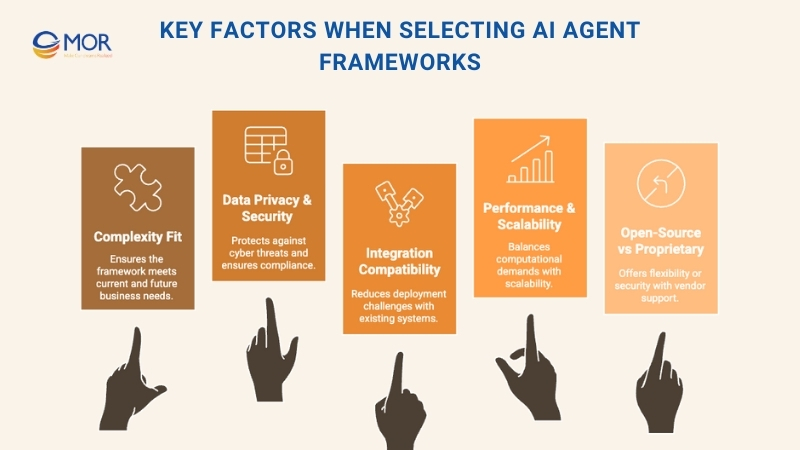
Matching Framework Complexity To Business Needs
The level of challenge your AI agents must handle can vary widely, from a simple customer-facing chatbot to a sophisticated, multi-agent system that enables inter-agent communication and collaborative decision-making.
The chosen agent framework should not only meet current requirements but also be adaptable enough to handle future growth and evolving demands.
Addressing Data Privacy And Security Risks
Enterprise-grade AI often requires agents to access both internal and external data sources, including APIs, to perform complex reasoning and execute tasks. Yet, in 2024 there was a reported 76% surge in data theft and a 75% increase in cloud intrusions.
This makes it essential to safeguard sensitive information and maintain compliance with relevant regulations. Strong security measures are critical not only for protecting data but also for gaining stakeholder trust in the AI agents framework once deployed.
Ensuring Smooth Integration With Existing Systems
When evaluating an AI agent framework, it’s important to assess how seamlessly it can connect with your organization’s existing technology stack. The ideal solution should support integration with multiple data sources, third-party software tools, different language models, and core enterprise systems already in place.
This compatibility minimizes deployment challenges, shortens development timelines, and ensures the agent AI framework operates efficiently within your current workflows and infrastructure.
Considering Performance And Scalability
In his 1994 book The Language Instinct, cognitive scientist Steven Pinker helped bring wider attention to Moravec’s paradox, which notes that tasks humans find effortless, such as recognizing faces or navigating physical spaces, can be computationally demanding for AI.
Meanwhile, activities involving complex calculations or high-level reasoning are often easier for machines to automate.
This insight still applies to modern AI development services, especially when assessing the performance demands of an AI agent framework.
Enterprise projects may involve advanced interactive agents or multi-agent systems that need significant computational power to handle perception-heavy tasks. This places them on the “harder” end of Moravec’s paradox.
In other cases, the priority may be a framework optimized for simpler, computationally lighter tasks, where ease of integration outweighs raw performance. Choosing the right fit ensures the AI agents tools can operate efficiently while scaling with future needs.
Weighing Open-Source Versus Proprietary Options
Open-source AI agent frameworks make their source code publicly available, allowing users to modify, redistribute, and adapt them freely. These solutions provide notable benefits, including transparency, customization flexibility, broad accessibility, and lower upfront costs.
Yet, in enterprise settings, open-source tools can present challenges. They may lack advanced security features, certain compliance certifications, and formal vendor support.
This means organizations must take additional steps to safeguard data, address compliance requirements, and account for potential biases or inaccuracies in the training datasets that power open-source AI agents tools.
Proprietary frameworks, in contrast, are owned by vendors and require a license or purchase. They often come with dedicated support, rigorous testing, and streamlined integration into enterprise systems. Many also include strong security controls, audit capabilities, and industry certifications suitable for regulated sectors.
Still, proprietary solutions can limit transparency, increase reliance on a single vendor, and reduce control over data handling. Businesses adopting these frameworks must evaluate how their information will be stored, processed, and protected, as well as the potential risks tied to vendor lock-in.
Unlock The Full Potential Of AI Agent Frameworks With MOR Software
Choosing the right AI agent framework is only the first step. Successful deployment requires careful planning, customization, and integration into your existing systems. That’s where MOR Software comes in.
- Framework selection: We evaluate your business needs and recommend AI as a service that fit your goals, industry requirements, and technology stack.
- Custom development: Our team tailors the framework’s workflows, logic, and integrations to suit your operational processes.
- Security and compliance: We apply enterprise-grade security practices, ensuring your AI systems meet regulatory standards.
- Seamless integration: From connecting APIs to linking internal databases, we make sure your AI agents work flawlessly with your current infrastructure.
- Ongoing optimization: We monitor performance, fine-tune workflows, and adapt your AI setup to changing business demands.

With MOR services as your partner, AI agent frameworks become more than just tools. They become a strategic advantage for automation, efficiency, and innovation.
Conclusion
The right AI agent frameworks can transform how enterprises build, deploy, and scale intelligent systems. From lightweight tools for rapid prototyping to advanced agentic AI frameworks supporting complex multi-agent workflows, each option comes with unique strengths and trade-offs. If you’re ready to turn intelligent automation into a competitive advantage, contact MOR Software today.
MOR SOFTWARE
Frequently Asked Questions (FAQs)
Which AI agent framework is best for large enterprises?
For enterprises deeply integrated with Microsoft tools, Microsoft Semantic Kernel is ideal for gradually introducing AI automation. Organizations seeking advanced multi-agent collaboration can turn to AutoGen, which provides a modular, enterprise-grade environment for real-time AI interaction. In highly regulated industries, LangGraph is a strong choice thanks to its stateful workflows, human-in-the-loop capabilities, and compliance-focused decision-making.
How do AI agent frameworks handle security and compliance?
Security is managed through role-based access control, audit trails, and permission-based data retrieval. Frameworks like LlamaIndex and LangGraph offer strong data governance features, making workflows transparent and traceable. They also support encryption for data at rest and in transit, and can be extended to meet enterprise-grade compliance standards.
What industries benefit the most from AI agent frameworks?
AI agent frameworks are making a major difference in customer service, healthcare, finance, HR, supply chain, manufacturing, and marketing. They cut inefficiencies, simplify complex workflows, and speed up operations. By powering intelligent agents that automate tasks, refine processes, and support smarter decisions, these frameworks are helping enterprises unlock significant business value.
What is the difference between an AI agent and a chatbot?
A chatbot is rule-based, handling simple and predictable conversations. An AI agent works autonomously, with the ability to reason, adapt, and make decisions across entire workflows, not just within a single chat exchange.
What is the learning curve for using these frameworks for non-technical users?
Frameworks such as Botpress and LangGraph provide visual builders and ready-made templates that make them more accessible to non-technical users. That said, tasks like configuring integrations or creating custom logic usually still require some level of technical support.
Rate this article
0
over 5.0 based on 0 reviews
Your rating on this news:
Name
*Email
*Write your comment
*Send your comment
1